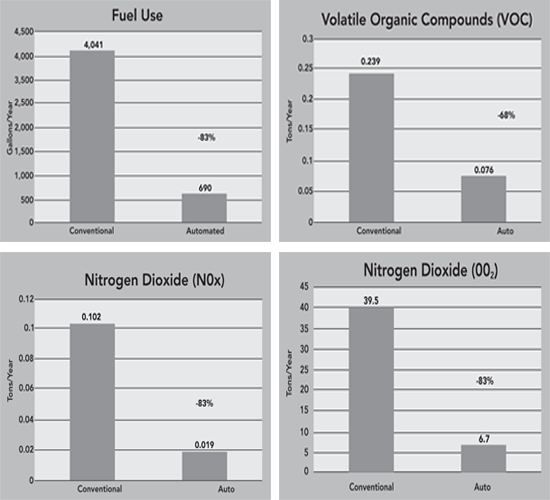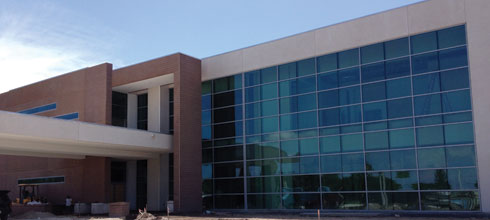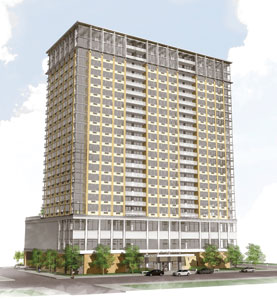Robots Update the Parking Garage
Operation and Maintenance
Surprisingly, the ongoing electrical costs for a fully enclosed automated parking system garage are typically less than that for a fully enclosed self-park garage. This is because fully enclosed self-park garages must be well-lit 24/7 and require the ventilation system to maintain 7–10 air changes per hour throughout the entire structure to clear exhaust and other fumes. In an automated parking system garage, cars are switched off in the parking bays and nobody is permitted to enter the parking areas (exceptions are occasional visits by the maintenance crew). Lights can be left off most of the time and the ventilation system need maintain only 2 air changes per hour. (Proper lighting and 7-10 air changes per hour are still required for exit/entry and waiting areas.)
In a comparison of expenses and capital costs for a parking alternatives case study in Upper Manhattan, New York City, former N.Y. City traffic commissioner Samuel I. Schwartz, P.E., president and CEO of Sam Schwartz Engineering, PLLC, found that total expenses were $825,000 for automated parking compared with $1,750,000 for conventional parking. Schwartz concluded “When all factors are considered, the cost of operating an automated garage is less than half (-55%) that of a conventional garage. In this particular case an operator can save over $1.1 million/year with automated parking. In the current real estate climate, this is equivalent to a capital cost savings of over $15 million.”2
| Advantages of Automated Parking |
Some of the potential advantages of automated parking over conventional parking include:
– Space gained can be used for green space and open areas. – Reduced fuel consumption. – Reduced power required because of minimal HVAC and lighting needs. |
Sustainability and Automated Parking Systems
Reducing the impact of parking allows more area for design features, green space, and communal areas for a project.
An automated parking system also reduces the environmental footprint of parking. In the same study mentioned above comparing an automatic garage with a conventional garage, Samuel I. Schwartz, P.E., found that in an automatic garage volatile organic compounds were reduced by 68 percent, carbon monoxide by 77 percent, nitrogen oxides by 81 percent, and carbon dioxide by 83 percent. The fuel savings also averaged 83 percent.
 |
|
Comparison of expenses and capital costs for Parking Alternatives Case Study: Upper Manhattan. New York City. Source: The Garage of the Future Must be Green, March 2009 issue of Parking, the National Parking Association’s magazine 1. See Labor Schedule |
 |
In a comparative study an automatic garage was found to have lower fuel consumption and to have less noxious exhaust gases than a conventional garage. Source: The Garage of the Future Must be Green, March 2009 issue of Parking, the National Parking Association’s magazine |
LEED® Points
Parking garages can contribute to LEED–NC 2009 points in several categories with automated parking systems eligible for Gold and conventional garages eligible for Silver certifications:
Sustainable Sites
Automated garage 20 points; conventional garage: 17Water Efficiency
Automatic and conventional garage 2 points eachEnergy & Atmosphere
Automatic and conventional garage 24 points eachMaterials & Resources
Automatic and conventional garage 6 points eachIndoor Air Quality
Automatic garage 6 points; conventional garage 2 pointsDesign Innovation
Automatic garage 2 points; conventional garage 4 points (1 point is for a management plan for car pooling)Total points: Automated Garage: 60 points (Gold); Conventional Garage: 55 (Silver)
(For LEED category credit-by-credit details see Achieving Sustainable Design with Automated Parking by Don Monahan, Vice President, Walker Parking Consultants (http://ebookbrowse.com/)
Issues for Design Professionals
Skepticism
Despite the fact that virtually every building type requires a parking solution, architects, as earlier noted, have not expressed huge interest in new ways to deliver parking. This has not gone unnoticed by the parking industry itself. Parking engineer Leon Hamelink author of The Mechanical Parking Guide 2011, refers to “the phenomenon of skepticism” regarding automated parking. Believing that “unfounded negative attitudes” are based on gut feeling, he proposes the following positive considerations, all based on his own experience:
For the architect, he suggests pointing out that an automated parking system allows more freedom in establishing layout and routing. For the developer an increase in return on investment. For the construction engineer, more space for bearing walls and columns if the parking system is in a basement. And for the local government body, helps fulfill neighborhood parking demand and delivers less environmental impact.
Evaluating Suppliers for Automated Parking Systems
A single domestic supplier that can deliver all aspects of an integrated automated parking system is preferred over a value added re-seller that is merely synthesizing the pieces from multiple sources for the mechanical systems, software, kiosks and other components. This is important simply because there is little recourse in the event of problems. A single experienced manufacturer can provide design and engineering services, fabrication, installation, support, testing, quality control, software programming and project management, plus the legal protection of holding one party accountable for the entire project.
Case Studies
| Park Terrace |
A multi-family residential building in a densely populated area of New Jersey has a garage for 460 vehicles and is sited on an odd shaped plot. The AGV system is the first known contiguous automated parking system created on an L-shaped layout. This was only possible because the AGV robot is able to move freely across the concrete, whereas all other automated parking systems are restricted to one lane of lateral movement along one set of steel rails, making it impossible for them to follow an L-shaped path. |
| The Costa Hollywood, FL: AGV System |
The Costa Hollywood, Hollywood Beach, Florida, will offer a mix of state-of-the-art condominium units, hotel rooms, restaurants, and an outdoor mall featuring boutique shops. “We have been careful to incorporate what we feel is an exciting and attractive building design and to utilize cutting edge technology,” says owner Moses Bensusan, CEO of Costa Hollywood. An AGV parking system for 176 vehicles was selected after carefully considering and studying multiple other systems. Ground breaking is scheduled for 2012. |
| Elliott Museum, FL |
|
Location: Stuart, FL The Historical Society of Martin County realized that their sizable collection of antique vehicles at the Elliott Museum in Stuart, Florida, needed to be stored in highly secure manner that didn’t use a lot of real estate and yet allowed the museum patrons to “interact” with the exhibit. They decided to employ a fully automated parking system, which enables cars to be retrieved to a turntable where they could be rotated in front of patrons. After an exhaustive search and competitive bidding process, the Historical Society selected a 55-car mono-path hoist/shuttle automated parking system. In addition to paying a competitive price, the Society took comfort from the fact that they chose a U.S.-based manufacturer with prior experience in Florida.  |
| Crystal Springs Resort |
Location: Hardyston, NJ The first commercial operation of a AGV parking system is at Crystal Springs Resort, a resort hotel in Hardyston, NJ. Completed in 2011, it has a capacity of 40 vehicles for employees. |
When selecting a supplier, Hamelink recommends creating a matrix that includes weighted criteria such as supplier maturity and the proposed system's speed, compactness, usability, and redundancy.
Conclusion
There are many advantages in installing automated parking systems. Compared with self- or attendant-parking garages, they have double storage capacity, allow more square footage for higher yielding development, have reduced excavation, construction and operation costs, and deliver a higher return on investment. They also have considerable appeal for car owners who are all too familiar with the hazards of conventional parking systems. Automated parking systems, including mono-path systems, have improved over the years, but new robotic Automated Guidance Vehicle (AGV)-based systems deliver more efficiency that appeals to both developers and customers and promises to further revolutionize the parking garage.
| ENDNOTES | |
| 1 | The Parking Garage: Design and Evolution of a Modern Urban Form by Shannon S. MacDonald |
| 2 | The Garage of the Future Must be Green, March 2009 issue of Parking, the National Parking Association's magazine |
 |
Boomerang Systems, Inc. is the leading U.S. manufacturer of highly space-efficient mechanical and robotic parking systems. The Company’s RoboticValet™ is the first system to use omni-directional robots to park cars on concrete slabs, making it the easiest system in the world to approve, construct, and operate. www.boomerangsystems.com |




 Location: West New York, NJ
Location: West New York, NJ Location: Hollywood Beach, FL
Location: Hollywood Beach, FL



